- page 6 -
(The Study of Threes)
http://threesology.org
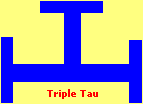
Triple Tau is one of the most important symbols of Royal Arch Masonry. It has been said that three Taus come together to form the Triple Tau. Others say the Triple Tau is originally the coming together of a T and an H, meaning Templum Hierosolyma, or the Temple of Jerusalem. Christians interpreted the symbol as "Holiness supporting Trinity". Royal Arch records dating from 1767 show this symbol. In addition to meaning Templum Hierosolyma (The Temple of Jerusalem), it is also said to mean Clavis ad Thesaurum - "A key to the treasure" - and Theca ubi res pretiosa - "A place where the precious thing is concealed."
Three-patterned references in the Five Platonic Solids:
| Plato | Volume | Shape of Face | Faces | Edges | Corners | Degrees | Illus. # |
| "Heaven" | Dodecahedron | Pentagon | 12 | 30 | 20 | 5040 | 1 |
| Fire | Tetrahedron | Triangle | 4 | 6 | 4 | 720 | 2 |
| Air | Octahedron | Triangle | 8 | 12 | 6 | 1440 | 3 |
| Earth | Hexahedron | Square | 6 | 12 | 8 | 2160 | 4 |
| Water | Icosahedron | Triangle | 20 | 30 | 12 | 3600 | 5 |
(We could also include the numerical references 6, 12, 30, {or the degrees} which are divisible by 3. In addition, the "Penta" in pentagon references the quantity "five". A triangle is viewed as the quantity "3". A square is "four" sided structure. Hence, the Pythagorean theorem which includes the 3, 4, 5.)
Illustration #1 |
Illustration #2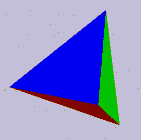 |
Illustration #3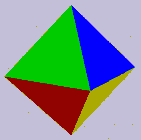 |
Illustration #4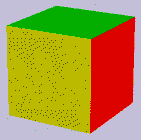 |
Illustration #5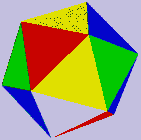 |
#1: Dodecahedron #2: Tetrahedron #3: Octahedron #4: Hexahedron #5: Icosahedron |
3-part Synoptic Mission Vision by George R. Hunsberger:
(Persistent Polarizations)
A three-orbed view of mission (koinonia, diakonia and kerygma) is crucial in order to respond to the almost constant tendency to polarize alternate visions of the church's mission. That polarization happens due to the tendency to see two sides of the triad as competitors for sole or primary focus.
Evangelism and social responsibility. An inadequate ecclesiology on both sides fuels the debate. (Evangelicals and liberationists.)
Mission and unity. A church-centric view too much dominates the perspective of both sides and misses the relationship of the church to the reign of God and therefore the world. (Ecclesiastics and church-planters.)
"Unity of the Church and the Unity of Mankind." Each tends to miss the proclamation of the Gospel of the reign of God as the birthplace and goal of both unities. (Ecumenists and Utopians.)
3 dictionary-related examples for the word eschatology: (Various Christian doctrines concerning:)
- The Second Coming (of Jesus).
- The resurrection of the dead.
- The Last Judgment.
There are three Letters in the Greatest Name, and in symbolism three is usually indicative of perfection (the Manifestation, the Holy Spirit and God). Three times three or nine, is the superlative of three, which indicates absolute perfection. The word BHA’ is composed of three letters, indicating the three part Revelation, which is equal to nine when completed, or the perfection of the Greatest Name. The Revelation of the Greatest Name will not be complete until the third Letter of the Greatest Name is revealed.
Three Aramaic dialects (Jewish-Aramaic, Syriac, and Mandaic) are normally inscribed on "demon" bowls, though others are known to have been inscribed in Persian (Pehlevi). Within the wide category of protective magic, one local tradition stands out as unique, namely the so-called Babylonian demon bowls. These inscribed earthenware vessels were found in several sites in Iraq and Iran, dating from the 6th to the 8th centuries A.D. and are unknown outside that region.
Everything comes in threes. Here is a quick study of the threes of the Bible.
| Three Levels of everything | ||||
| Who or what | 1 | 2 | 3 | Reference |
| Temple Area |
Outer Court | Place of Holies | Holy of Holies | |
| Allowed into the Temple |
All who seek The God of Abraham Isaac & Jacob |
Circumcised | Priest once a year |
|
| Temple Lighting |
Sun | Menorah | Light of God | |
| Type of lighting | Natural | Holy Spirit | God | |
| Jesus | Guests | Servants | Bride | Matt 22:1-4 Matt 25:1-12 |
| John | Children | Young Men | Father | 1 John 2:12-14 |
| Children | Sons | Father | ||
| Sin Forgiven | Know the Word | Know God through the word |
||
| Paul | God's will | Acceptable will | Perfect will | Romans 12:1-2 |
| To You | In You | Through You | ||
| Fruit | 30 | 60 | 100 | Mark 4:13-20 |
| Festivals | Passover | Pentecost | Tabernacles | |
| Jesus | Way | Truth | Life | John 1:4-6 |
| Way out of Egypt | Mt. Sinai | Promised Land | ||
| Death Angel | Receiving the Torah | Lives with God | ||
3 forms of angels in the bible:
- God Appearing as an Angel.
- Angels as God’s Messengers to People.
- Angels Who Remain in God’s Presence.
3 Classic descriptions of the mystical experience in Christianity:
- In 2 Corinthians 12:2-3.
- In Augustine [354-430] (Confessions Book 7, ch. 17; Book 9, ch. 10).
- Bernard of Clairvaux (1090-1153).
In its 'classic' Christian form the mystical experience proper was understood as the final phase of a three-fold path:
- In the first (the purgative) the believer practiced the purgation of sin.
- In the second (the illuminative) the development of a virtuous life.
- In the third (the unitive) the believer experienced union itself.
The unitive experience was generally understood as a union of essences in which the believer retained his individuality (in distinction to essential union described in much Eastern mysticism in which the believer is lost in the divine) and as open to only a few. By the 15th century this threefold path was democratized and mystical vocabulary was often used to describe every Christian's union with Christ in faith and particularly when receiving the Eucharistic sacrament.
3 to 1 ratio of the "many" approaches to the labyrinth. One Christian approach to the labyrinth is based on the "threefold path" of Purgation, Illumination, and Union. These represent three stages in a labyrinth walk:
Releasing (Purgation)- From the entrance to the goal is the path of shedding or "letting go." There is a release and an emptying of worries and concerns.
Receiving (Illumination). At the center there is illumination, insight, clarity, and focus. It is here that you are in a receptive, prayerful, meditative state.
Integrating (Union). Empowerment and taking ownership. The path out is that of becoming grounded and integrating the insight. It is being energized and making what was received manifest in the world.
There are three stages but one path, and it is different for everyone.
Probably the oldest recorded dreams and their interpretations are found in the ancient tale-Babylonian Epic of Gilgamesh, which originated some 2000 years B.C... The Epic of Gilgamesh (Gilgamesh was a Sumerian king), was originally part of the cultural heritage of all the oriental nations and was translated into many different languages. The story tells of Gilgamesh's ancestor, Utnapishtim, the only immortal being on Earth, and of Gilgamesh's long adventure-filled journey with Enkidu, his friend from the Steppes, in search of eternal life and the way to overcome death. Some lines from the poem are: 'Shall we find the trail of Humbaba (an enemy warrior) thus? Let us look at some dreams, one after the other. May the dreams be threefold'...
3 realms or dimensions of Buddhist cosmology:
R_ga-Dh_tu: Desire, sensual or gross material world, in which beings experience a strong attachment to sensory objects and sensory pleasure.
R_pa-Dh_tu: Form or subtle material world in which beings experience very less attachment to sensory objects and sensory pleasure, but experiences a high degree of attachment to inner mental joy and bliss.
Ar_pa-Dh_tu: Formless or immaterial world in which beings experience no attachment to sensory objects at all but solely remain in a total meditative absorption, experience neither pleasure not pain.
Three Buddhist Classifications of a person which come together under suitable conditions:
- The Five Skandhas
- The Twelve Bases
- The Eighteen Fields
Three Delusions produced by three doubts in the mind of Bodhisattva (In Tien Tai):
- Through things seen and thought.
- Through the immense variety of duties in saving humans.
- Through ignorance.
Three Dogmas: Void, Unreal and Mean.
[Also known as Three Inconceivable Meditations, which is one of the practices in Tien Tai Sect in China. According to Tien Tai, all existence in the universe consists of Three Dogmas (Truths), namely, Void, Unreal and Mean. These three Dogmas are co-existent and interactive, integrated and interrelated. If one can meditate this concept with the whole mind, it is call Three Meditations of One mind, or Inconceivable Profound Meditation.]
Three kinds of Enlightenments:
- Enlightenment for self.
- Enlightenment for others.
- Perfect enlightenment and accomplishment (i.e. Buddha).
The first is Arhat. The second is Bodhisattva. When all the three have been attained, the being becomes a Buddha. (A 3 in 1 ratio.)
Three Evil Paths: They are the three lowest realms of the Nine Realms: hell, hungry ghost and animal.
Three Good Paths: Man, Asura and Deva Paths.
Three Jewels- or the Three Precious Ones: The Buddha, The Dharma, and The Sangha, which are the three essential components of Buddhism. They are the objects of veneration. Buddhists take refuge in them by pronouncing the threefold refuge formula,thus acknowledging themselves to be Buddhists.
Three Obstructions- also called Three Obstacles. They are the obstructions that hinder the attainment of Buddhahood. When the Three Obstructions are cleared, the Three Virtues will be perfected:
- Affliction obstruction - due to Three Poisons, i.e. greed, hatred and stupidity.
- Karma obstruction - due to Five Offenses, and Ten Unwholesome Deeds, i.e. Karma in the past.
- 3. Retribution obstruction - the suffering retribution in Three Evil Paths.
Three Periods of Time: Past, Present, Future.
Three Poisons- or Three Roots (source of all the passions and delusions):
- Greed or wrong desire.
- Hatred or anger.
- Illusion or stupidity or ignorance.
Three Realms- Sanskrit word is Triloka. It is Buddhist metaphysical equivalence for the triple world of earth, atmosphere and heaven:
Realm of Sensusous Desire- (Sanskrit word is Kamadhatu) of sex and food. It includes the Six Heavens of Desire, the Human World and the Hells.
Realm of Form- (Sanskrit word is Rupaadhatu) of matter which is substantial and resistant. It is a semi-material conception. It is above the lust world and contains bodies, places and things, all mystic and wonderful. It consists of 18 heavens, including the Heavens of Four Zen (Sanskrit word is Brahmalokas).
Realm of Formlessness- (Sanskrit word is Arupadhatu) of pure spirit, where there are no bodies and matters to which human terms would apply, but where the mind dwells in mystic contemplation; its extent is indefinable, but it is conceived of in Four Stages/Places of Emptiness in the immaterial world. It has four heavens, in which the Sphere/heaven of neither-perception-nor-non-perception is the highest.
The three (evil) roots: Desire, Hate and Stupidity.
Three grades of good "roots" or abilities: Superior, Medium, Inferior.
Three Seals- (also known as Three Universal Truths):
- All phenomena are impermanent.
- All Dharma are not-self.
- The eternity is Nirvana.
[It is called the seal because it is to certify whether it is the Buddha's teaching or not.]
Three Shastra:
- Madhyamaka Shastra
- Dvadashamukha Shastra
- Shatika Shastra
[All three were translated by Kumarajiva, on which the Three Shastra Sect bases its doctrines.]
Three Studies- (or Three Vehicles of Learning):
- Sila, i.e. taking Precepts
- Dhyana, i.e. concentration and meditation
- Prajna, i.e. wisdom
[It is practiced by the Arhats.]
Three Sufferings:
- Feeling of suffering
- Feeling of happiness - suffering of decay
- Feeling of neither suffering nor happiness - suffering of the activity of the Five Skandhas.
Three Universal Characteristics- The Three Universal Characteristics are connected with the existence:
- All phenomena are impermanent.
- All Dharma are not-self.
- All sensations are suffering.
Three Vehicles-: Sravaka, Pratyeka Buddha, and the Bodhisattva.
Three Virtues of power:
- The virtue, or potency of the Buddha's eternal, spiritual body, i.e., the Dharmakaya.
- The virtue of his Prajna, knowing all things in their reality.
- The virtue of his freedom from all attachments and his sovereign liberty.
Three kinds of Wisdom:
- Sravaka and Praetyka-Buddha knowledge that all the Dharmas or laws are void and unreal.
- Bodhisattva knowledge of all things in proper discrimination.
- Buddha knowledge or perfect knowledge of all things in their every aspect and relationship past, present and future.
[In Tien Tai Sect, the Three Wisdom is associated with the Three Dogmas of Void, Unreal and Mean.]
Threefold Body of a Buddha:
- Dharma body, i.e. Dharmakaya - its own essential nature, common to all Buddhas.
- Retribution body, i.e. Sambhogakaya - a body of bliss, which he receives for his own use and enjoyment.
- Response and transformation body, i.e. Nirmanatkaya - he can appear in any form whenever and wherever necessary for the sake of crossing over others.
Threes used in the Tien Tai Sect: One of the Ten Great Sect in Chinese Buddhism. It was initiated by Hui Man in the dynasty of Bei-Chai, and was promoted by Chi-Hai in Tsui Dynasty. Mainly based on Lotus Sutra, Tien Tai Sect explains all universal phenomena with Three Dogmas. For the practices, it emphasizes cutting off Three Delusions, thus establishes the method of Three Meditations of One Mind.
Trinity of Western Paradise- They are the Buddhas and the Great Bodhisattvas in Western Paradise (Pure Land of Ultimate Bliss):
- Amitabha
- Avalokitesvara (Kuan Yin)
- Mahasthamaprapta
Tripitaka- Tripitaka in Sanskrit, Tipitaka in Pali.& The three parts of Pali canon, consisting of:
Sutra-Pitika (Sanskrit) or Sutta-Pitaka (Pali), or the Sutra Basket - containing the entire , the sermons attributed to the Shakyamuni Buddha.
Vinaya-Pitika (both Sanskrit and Pali), or the Ordinance Basket - containing the rules of monastic life.
Abhidharma-Pitika (Sanskrit) or Abhidhamma-Pitaka (Pali), or Shastras, or the Treatise Basket - containing the doctrinal commentaries, philosophical and technical works, such as discourses, discussions, or treatises on the dogma, doctrines, etc.
Three Aspects of Learning to Be Without Outflows:
- Moral precepts
- Samadhi
- Wisdom
"Diligently cultivate precepts, samadhi and wisdom; Put to rest greed, hatred, and stupidity.
Three Worlds:
- World of desire
- World of form
- Formless world.
Three colored -fireballs (red, pink and orange) are said (by some scientists) to be caused by flammable natural gas deposits in the (Mekong) river bed drawn to the surface by the moon's gravitational pull. The phenomenon occurs yearly on the first full-moon night of October, coinciding with the end of Buddhist Lent in Thailand. The common view is that the fireballs come from a mythical serpent living in the Mekong River in the north eastern province of Nong Khai, are known as Naga's Fireballs.
The image below represents what is said to be an often quoted passage from the Zohar, the book of Jewish mysticism:
Yisroel Voraysa V`Kudsho Brichu Chod Hu
Israel and the Torah and Hashem are one
These three are interpreted to represent a formula of "oneness" in terms of individual uniqueness and is not defined as an example of a Trinitarian concept. It is said that for 2,000 years, Christians have tried to convince the Jews that the Trinitarian view of God (Father - Son - Holy Spirit/Ghost) is the same as the Jewish view. It is further stated that the Trinitarian view is found nowhere in the Torah, and did not become official Church doctrine until the 4th Century CE. It is felt that since the jewish ancestors of the Torah "had not known" a triune God, that is all present day Jews have to know to reject such an idea.
However, what neither the Jews or Christians are taking into consideration is the representation of the Torah and Christian writings as illustrations of different human brain architecture (cognition) from earlier periods to later periods. Hence, the later Christian writings (such as the New Testament) show an increase in a "threes" usage as is detailed in the life of Jesus. The further we go back in time, there is a decrease in the usage of "threes" in religious writings as well as a predominantly preferential three-patterned perspective.
(Equating "oneness" with "uniqueness" with "chosen" is itself a trinitarian formula.)
Three stages of perfection in the (Christian) believer:
- Justification
- Sanctification
- Baptism of The Holy Spirit
Three cleansings of the Earth:
- The first by water- the great flood.
- The second by the blood of the lamb- the spilled blood of Jesus at his crucifixion.
- The third is to be by the Holy Fire of God- Nuclear? Chemical? Biological... or a Trinity of all three?
Initially created: Saturday, January 01, 2011
First Posted: Friday, April 4, 2014
Herb O. Buckland
herbobuckland@hotmail.com